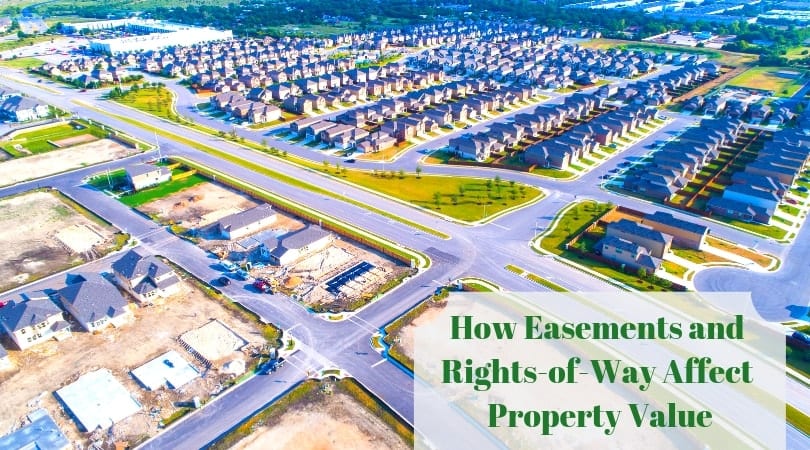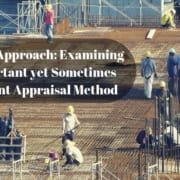How Easements and Rights-of-Way Affect Property Value
Categories: Commercial Appraisals, Development, Real Estate Appraisal, Real Estate Tips
Most improved real properties and many vacant tracts can only be sold subject to existing easements. Appraisers identify existing easements and consider their effect on value whenever a market value definition is part of an assignment. Easements and rights-of-way often influence how real property can be used and may even affect a property’s ownership cost.
Identifying Existing Easements
When an owner has exclusive rights to a building, the property is said to be owned in “fee simple.” But when any part or use of the property is held by another, that part is a “fractional interest.” The interests can be physical, in title, financial, by specific use, or over time. Easements are a type of fractional interest that grants an entity the right to use a specific part of a property separate from the rest of the property.
Physical easements—often used for utilities, roadways, and open spaces—can apply to a site’s surface, its underground, and the space above it. Rights-of-way provide access across a geographic area. They usually are composed of easements over many properties. Whole property easements limit the owner’s right to develop, improve, or alter the property. This type of property easements includes conservation, façade, and historical designation easements.
Appraisers can identify a property’s easements in several ways: recorded documents, such as deeds and mortgages, contain detailed legal descriptions that describe existing easements; a title search will reveal all recorded documents relevant to a property over time; development plats, site surveys, and site plans usually show surface easements.
How Existing Easements Can Affect Property Usage and Value
Utility easements are assigned for gas, electricity, water, sewage, and communication lines. In order to provide uninterrupted delivery of those services, their easements usually don’t allow buildings or surface disturbance. Some kinds of site improvements, such as landscaping, might be allowed. Access easements (for roads, sidewalks, emergency corridors, etc.) prohibit any uses that would block or interfere with passage across a property. These physical easements can reduce a site’s usable area, therefore, the size of potential building improvements. The presence of easements may also dictate improvement layout, such as building height, the placement of driveways, or secondary structures. At the same time, while usable site area is diminished, the property owner is often responsible for maintaining and paying taxes on easement areas.
Whole property easements determine the use of an entire site. Conservation easements forbid improvement of land beyond its current use. Historic preservation easements limit the demolition of existing improvements. Façade easements require that existing improvements be maintained within a specific set of guidelines such as paint colors, materials, and architectural style; all of these restrict a property’s prospective alternate uses.
Value Estimates of Proposed Easements
The value of an easement is most often estimated through a “before and after” analysis. The appraiser develops two value opinions: one assuming no easement and the other reckoning the easement is available. The difference between these two opinions describes the easement’s value. When the intended use of the easement appraisal is to determine just compensation for eminent domain, the appraiser generally identifies which portion of the easement value results from damage done to the property in the “after” condition.
Some appraisers and easement purchasers use alternative methods to estimate easement value. The across-the-fence method compares actual prices paid for other nearby easements. Typically, this method is unreliable because an easement across a specific property affects each property’s use differently. The corridor method assumes a specific property’s easement value as a part of the acquisition cost of an entire right-of-way. Again, this method is unsound because it doesn’t consider the unique attributes of each easement within the right-of-way. Corridor valuation also sometimes ascribes added value to a group of easements over multiple properties.
Easement valuation is a specialized kind of real estate appraisal. Appraisers gain that special expertise through additional education, experience and, often, participation in professional organizations such as the International Right of Way Association.
Conclusion
A competent appraiser identifies existing easements, their limitations on usability and their effect on value for every subject property. Easements may reduce usable area of a site, the extent of improvements to the site, and future uses of the entire property. Careful review of sale documents, title insurance reports, site surveys, and development plats help the appraiser identify easements that are in effect on the date of appraisal. If quantifying the value of easement is part of an appraisal’s intended use, the most usual approach is “before and after” method. Easement and right-of-way valuation are an appraisal specialty. Appraisers and clients should ensure that competency requirements are met in this kind of assignment.







Spot on with this write-up, I actually assume this web site wants much more consideration. I’ll in all probability be again to learn way more, thanks for that info.